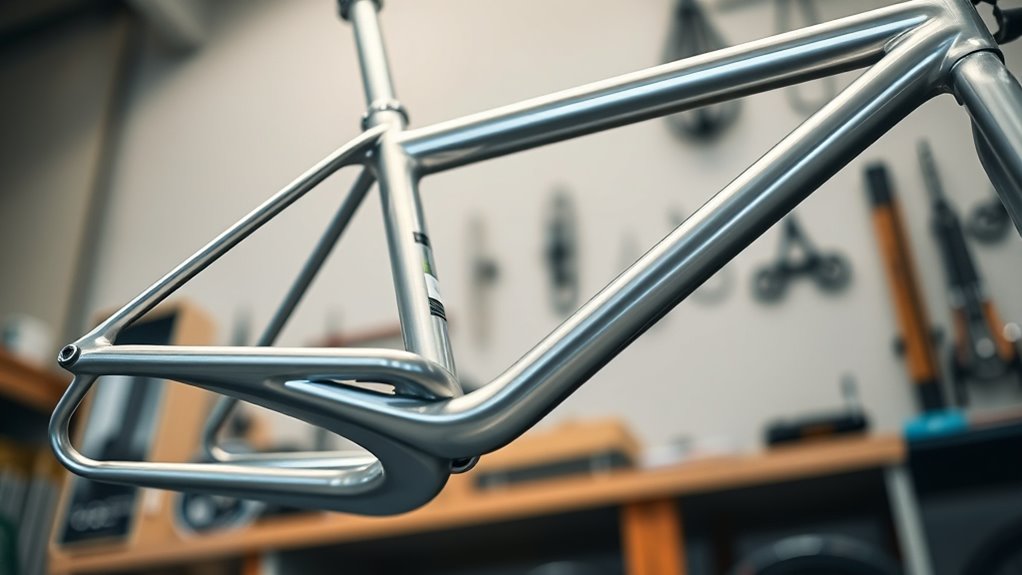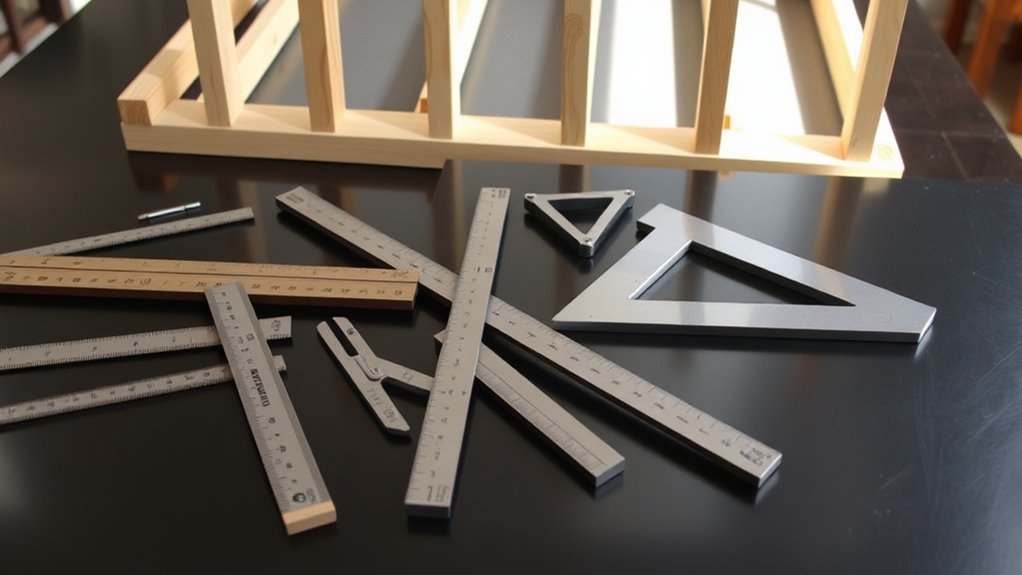Choosing the right frame geometry depends on your riding style, terrain, and comfort needs. If you prioritize stability and long rides, opt for a slack head tube angle and longer wheelbase. For agility and quick turns, go for steeper angles and shorter chainstays. Balancing top tube length and bottom bracket height affects your posture and handling. Understanding how these aspects work together helps you build a bike that feels just right—keep exploring to learn more about customizing your build.
Key Takeaways
- Match head tube angle to desired stability or agility, with slack for descents and steep for responsiveness.
- Choose top tube length based on preferred riding position—longer for stability, shorter for maneuverability.
- Select chainstay length to balance stability and responsiveness, with longer for load stability and shorter for agility.
- Adjust bottom bracket height to optimize cornering and ground clearance according to terrain and riding style.
- Align geometry with your riding goals, considering factors like speed, comfort, and terrain to enhance overall performance.

Are you choosing the right frame geometry to match your riding style and goals? Your bike’s geometry directly influences how it handles and how comfortable you feel during rides. Whether you’re tackling technical trails, cruising on long-distance rides, or commuting through city streets, understanding how different geometry aspects impact bike handling and riding comfort can help you make smarter choices.
First, consider the head tube angle. A slacker angle, around 64-66 degrees, offers more stability and confidence on descents, making it ideal for downhill or mountain biking. Conversely, steeper angles, close to 70-73 degrees, provide quicker steering and responsiveness, which benefits road racers or riders who need sharp handling. Your choice here affects bike handling profoundly; a slack angle can make your bike feel more planted at high speeds, while a steeper angle enhances agility at lower speeds.
A slacker head tube angle boosts stability on descents; steeper angles enhance quick steering and responsiveness.
Next, think about the top tube length. Longer top tubes stretch out your riding position, providing more stability and comfort on longer rides, especially if you prefer a more relaxed posture. Shorter top tubes create a more upright stance, which can improve riding comfort by reducing strain on your back and neck. This upright position also enhances bike handling in urban environments, giving you better maneuverability and control in tight spaces.
The chainstay length also plays a critical role. Longer chainstays tend to improve stability, especially when carrying loads or riding over rough terrain, but they can make the bike feel less nimble. Shorter chainstays increase maneuverability, making the bike more responsive and easier to handle on technical sections or in city traffic. This aspect of geometry balances bike handling with riding comfort, as longer stays can dampen vibrations, while shorter stays might transmit more road feel.
Additionally, the bottom bracket height impacts how your bike handles. A lower bottom bracket lowers the center of gravity, enhancing stability and cornering grip, essential for aggressive riding or mountain biking. However, too low can risk pedal strikes, especially on rough terrain. A higher bottom bracket offers more clearance and agility but can decrease overall stability.
Ultimately, matching your frame geometry to your riding style and goals helps optimize both bike handling and riding comfort. If you prioritize stability and comfort on long rides, a geometry with longer wheelbases and relaxed angles works best. For agility and quick responsiveness, choose geometry with steeper angles and shorter stays. By understanding these key factors, you ensure your bike not only fits your body but also performs precisely how you need it to, elevating your riding experience.
Frequently Asked Questions
How Does Frame Geometry Affect Riding Comfort?
Frame geometry directly impacts your riding comfort by influencing ergonomics optimization and frame stiffness. A more relaxed geometry offers a comfortable, upright position, reducing strain on your back and neck. Conversely, a race-oriented frame increases stiffness, making your ride more efficient but potentially less comfortable on long rides. Choosing the right geometry balances comfort and performance, ensuring you enjoy your ride without unnecessary fatigue or discomfort.
Can Frame Geometry Be Adjusted After Purchase?
Yes, you can adjust frame geometry after purchase, but it depends on your bike’s design. Some bikes feature adjustability features like seat angle or handlebar height, while others may require aftermarket modifications. Keep in mind that making significant changes might impact safety or performance, so consult a professional. Small adjustments can improve comfort and riding experience without extensive modifications, helping you personalize your bike to fit your riding style.
What Is the Impact of Seat Tube Angle on Performance?
The seat tube angle directly impacts your performance by influencing saddle height and seat positioning. A steeper angle positions you more forward, increasing power transfer and responsiveness, ideal for racing. A slacker angle offers comfort and stability for long rides. Adjusting your seat tube angle changes how you sit, affecting efficiency and comfort. Confirm your saddle height aligns with this angle for peak performance and reduced fatigue.
How Do Different Head Tube Angles Influence Handling?
Did you know that a 1-degree change in head tube angle can considerably affect handling? A steeper angle makes your bike more responsive, especially in tight turns, while a slacker angle offers stability at high speeds. Your fork length and chainstay angle also influence this feel—longer forks soften steering, while a more relaxed chainstay angle enhances comfort over rough terrain. Adjust these elements to tailor your bike’s handling to your riding style.
Is Frame Geometry More Important Than Material Choice?
Frame geometry is more important than material choice because it directly affects your bike’s handling, comfort, and performance. A well-designed geometry enhances frame stiffness for better power transfer and control, while considering material durability guarantees longevity. Even with top materials, poor geometry can lead to uncomfortable rides or poor handling. So, prioritize geometry to optimize your riding experience, then select materials that complement your riding style and durability needs.
Conclusion
Choosing the right frame geometry sets the stage for a smoother, safer, and more satisfying ride. By balancing your build’s basics with boldness and a bit of bravery, you’ll build a bike that’s not only beautiful but also perfectly poised for performance. Remember, the right frame fosters freedom, fosters fun, and fuels your fitness. So, focus, find your fit, and forge forward—your perfect bike awaits, ready to ride!
















